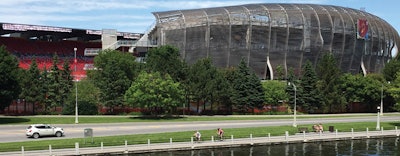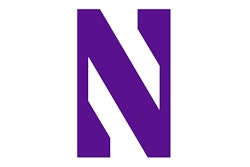
Stadiums across North America may differ in seating capacity, video board size or the retractability of their roofs, but they have traditionally followed a typical model: large complexes surrounded by a sea of parking, often disconnected from their surrounding communities and cities.
Recent design trends embrace a different model, recognizing stadiums as engines for economic growth, cultural renaissance and urban development. At the center of this trend in stadium development is Canada, which in recent years has hosted leading international competitions, including the 2010 Vancouver Winter Olympic Games, the 2015 Pan American and Para Pan Games, and the 2015 Women's World Cup. While there are numerous reasons for Canada's emergence as a hotbed of international sports competitions, its successful stadium design has been an undeniable component.
The development can be traced back to 2010, when Canada showcased the Richmond Olympic Oval, the signature venue of the 2010 Vancouver Winter Olympics and the first Olympic speed skating oval ever designed for legacy use. Now five years after the games, the ROO lives on as a valuable community center and recreation outlet for the City of Richmond and surrounding region. The facility has spurred the creation of a new urban waterfront neighborhood and continues to nourish and support it as an engine for economic growth.
This summer, the Women's World Cup put a spotlight on Lansdowne Park's TD Place, which stands as a fine example of how a stadium can integrate itself into a historic urban park. The new Hamilton Soccer Stadium was also on display this summer as it hosted events during the 2015 Pan American Games. Designed as a flexible neighborhood stadium, the venue is capable of hosting professional and amateur sports, cultural events and other competitions.
RELATED: Operators of Vancouver's Olympic Venues Balance Legacy, Economic Sustainability
These successful venues in Canada point toward a purposeful new direction for stadium design across North America, placing greater emphasis on community development. Here are five concepts driving the trend:
1. Understand the Bigger Picture
The first key to creating a valuable modern sports venue is recognizing the stadium is part of a much larger civic plan. When working on the Hamilton Soccer Stadium, the design team at CannonDesign spent extensive time reviewing the city's strategic plan. This research helped identify key criteria that guided design efforts from the outset. For example, the city's plan is focused on creating compact and healthy urban communities, strong environmental systems (land, air and water), balanced transportation networks and financial stability across a growing and diverse economy. Understanding these core civic goals and values informed the design of a stadium that offers key community gathering spaces and strong connectivity to public transit, and one that is in pursuit of, at minimum, a Canadian Green Building Council LEED silver rating.
2. Create Space for the Community
Forward-thinking stadium design aims to create inviting space for the community to enjoy. For the Richmond Olympic Oval, this meant strategic programming and the creation of a remarkably flexible interior space capable of hosting community meetings, ice sports and multipurpose activity courts all at once. In Lansdowne, this translated to a creative public space/stadium concourse that encircles the stadium and provides the public with opportunities to flow through the stadium structure while still in the park. In Hamilton, tree-lined sidewalks surround the venue, and all four corners are designed as public gathering areas. The South Plaza is specifically designed to be a community gathering space that can be used in conjunction with stadium events or in general as a wider community resource, hosting separate events, farmers markets and community organizations.
3. Think Big... and Then Smaller
One of the historical challenges of creating major international sports venues is they need to accommodate massive crowds during the competition, but much smaller audiences during less globally significant events. A year removed from the 2014 Men's World Cup in Brazil, many of the 12 stadiums built for the event have fallen into disuse or are struggling financially. It's key for design teams to find creative ways to allow stadiums to expand and retract in size to ensure the venues don't become large and burdensome for the community.
Lansdowne Park's TD Place was strategically designed to provide 24,000 seats for its regular events but can temporarily expand to 45,000 seats for major national and international events. Likewise, the Hamilton Stadium has a temporary seating capacity of 40,000 seats, allowing it to host events like the Grey Cup. These flexible-capacity venues need to be created with careful strategy; it's about much more than simply creating space for additional seats. The venues also must be equipped with the necessary support spaces, signage and concourse paths to accommodate each audience size.
4. It's Okay to Fit In
When designing a new stadium, it's easy for stakeholders to become too focused on finding ways to stand out from historic venues. Left unchecked, this strategy can result in venues that succeed in standing out from their surroundings but leave the local community feeling alienated by the presence of these "eyesores." While creating a unique brand is still important, design teams should also look around at the surrounding community and incorporate common materials, colors and massing in order to deliver something that fits into the existing environment.
5. Design Differently
Innovative thinking and bold ideas can turn stadiums into assets for their home communities. In Hamilton, the new soccer stadium replaced a local landmark that had been part of the community for more than 60 years. Care had to be taken to design a stadium that paid tribute to this heritage but also moved the neighborhood in a positive new direction. Unlike its predecessor, the new stadium was oriented north/south, a strategic design change that made competition easier for athletes, reduced shadows cast on the surrounding neighborhood and allowed the venue to fit more comfortably in the site — reducing visual and physical impacts to the surrounding area.
RELATED: SPOTLIGHT: Stadiums and Outdoor Surfaces
Bob Fatovic, AIA, is one of CannonDesign's leading sports designers, working with collegiate, professional and community organizations
This article originally appeared in the September 2015 issue of Athletic Business with the title "Won't You Be My Neighbor?"
































